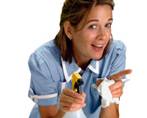 COMMERCIAL CLEANERS ARE TOXIC
COMMERCIAL CLEANERS ARE TOXIC
Many cleaning products contain metals, solvents and toxic chemicals. Many cleaners also contain unnecessary antibacterial agents (which are technically pesticides) that can actually make bacteria more resistant to antibacterial drugs. If poured down your drain, these chemicals can pollute our water system. Wastewater treatment processes are designed to treat biological wastes only. They cannot remove all traces of such pollutants before the treated water flows into our waterways.
Similarly these chemicals enter our bodies either by contact with the skin, through the nose, or mouth. Fortunately, our vital organs act to constantly neutralize, filter, and transport wastes from the body. The lungs, liver, kidneys, blood, intestines, lymph system and skin work together to help keep us free from harmful elements. However, it is difficult to keep up with the exposure to materials such as heavy metals, drug residue, pesticides, and petroleum based chemicals. When the body’s elimination system is overwhelmed, these toxins are stored deep in our tissues and continue to degrade our health. Illnesses such as asthma, skin diseases, and allergies are caused or exacerbated by an underlying sensitivity to these chemicals.
One way to reduce exposure to chemicals is to use less toxic cleaners in the home. Green cleaners are effective, inexpensive, and easy to make. |
|
|
HOW TO MAKE GREEN CLEANERS
There are alternatives to harsh cleaning products that are safe, economical and easy to use. Baking soda, borax, lemon juice and other ingredients are friendlier to our environment and our bodies. Here are some recipes that can easily be made at home.
❀ ALL-PURPOSE CLEANER: Mix baking soda with a little water, enough to create a paste consistency. Rub the paste into a stain with a damp cloth or sponge. For stubborn stains, work it in and let it sit for a few minutes.
❀ DISHWASHER DETERGENT & RINSE AGENT: Find out what you need to make your own dishwasher detergent and rinse agent for automatic dishwashers here.
❀ DISINFECTANT: Use undiluted distilled white vinegar as a spray to clean grimy surfaces such as walls, door knobs, etc. As an alternative use one-half cup of Borax in one gallon of hot water.
❀ DRAIN CLEANER: Try a using a plunger first. Baking soda, salt, vinegar, boiling water. Pour one-half cup baking soda and a quarter cup of salt into the drain, add one-half cup of distilled white vinegar. It will start to fizz. Cover drain with a damp cloth. Let it sit overnight for best results. Remove the cloth and flush with boiling water. Remember, do not use the baking soda combination or a plunger after using a commercial drain opener.
Avoid clogs, use drain strainers to trap food particles and hair. Collect grease in a container and put it in the garbage rather than rinsing it down the drain.
❀ GLASS CLEANER: Mix 2 cups water, 1 cup white distilled vinegar and 1 teaspoon liquid soap or detergent in spray bottle. Spray it on to remove wax residue left by commercial window cleaners. After that residue is removed, you can leave out the soap for future cleaning. Use lemon juice and water as an alternative. For a streak-free clean, polish the glass with newspaper.
❀ GREASE REMOVER: Spray or douse the spot with full-strength lemon juice or vinegar. Let sit a few minutes, then scrub and rinse with clear water.
❀ LIME & MINERAL DEPOSIT REMOVER: Hard lime deposits around faucets can be softened for easy removal by covering the deposits with vinegar-soaked paper towels. Leave paper towels on for one hour before cleaning.
❀ MILDEW REMOVER: Use undiluted white distilled vinegar on a cloth or sponge mop to wipe down surfaces.
❀ OVEN CLEANER: Scrub clean with baking soda and very fine steel wool. Sprinkle water on the surface followed by a layer of baking soda. Let stand overnight. Rub gently with a very fine steel wool pad. Wipe off scum with dry paper towels or sponge. Rinse well and wipe dry.
❀ SCUFFMARK & WATERMARK REMOVER: Toothpaste is effective in removing scuffmarks from floors and watermarks from wood furniture.
Contact your public works department or utilities to find out how to properly dispose of all toxic cleaning products.
METABOLIC BALANCE HELPS DETOX
Metabolic Balance® helps reduce sensitivities to chemicals by eliminating inflammation. It offers a scientific basis to determine which foods are best for each of us. Participants in the Metabolic Balance® program receive individualized meal plans that include the most wholesome foods that will work best with each person’s metabolism, detox and remove toxins from the body, and reach optimum health.
I offer weekly meetings for my clients for support and learning. Some of what I cover in the classes for my clients participating in my Metabolic Balance® program is to understand how chemicals in personal care products negatively affect the body and how to recognize cleaning products that promote health.
Metabolic Balance® has individualized programs for weight management & optimal health. If you are interested in finding out more about metabolic balance,® contact Myra. You can also visit MetabolicBalanceCalifornia.com. Sign up now for monthly news & tips.
RELATED POSTS
Are Personal Care Products Are Poisoning Our Planet?
Cleansing Your Body Through Diet Provides Deep Healing
Metabolic Nutrition Program Grows in the US

